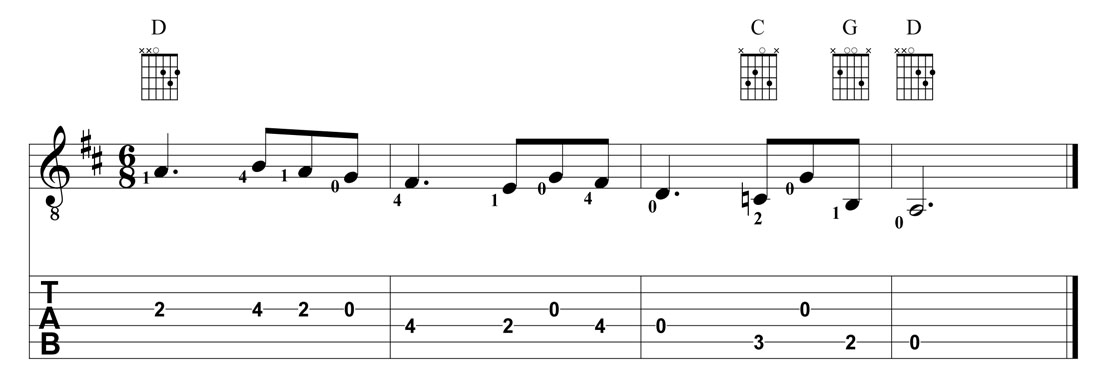Music Theory
Music Theory for guitar: Norwegian Wood
by John Lennon and Paul McCartney taken from the Beatle's recording on Rubber Soul.
1. The song is performed on the guitar with the tonal center of D. By placing a capo on the second fret the performance tonal center of E from the recording is achieved. The intro is the four bar (the song is in 6/8 time -more about that later) melody line played on guitar and doubled at the octave by Harrison's Sitar. Take a look:

the given chord fingering will allow the guitarist to pick the melody line over the chords. Note the C major chord has an added 9 (the note d on the second string) and the G major chord is in first inversion - that is the third of the chord - the note B is the bass note. This figure is repeated at the intro and in the middle instrumental break and then appears only once to finish the song.
2. I say 'tonal center' because the melody line of the verse is actually in the D mixolydian mode and the chorus melody line and its accompanying vocal harmony is from the parallel d minor scale. The mixolydian mode alters the leading tone of the major scale by flating it by a half step. For the key of D, the leading tone C# would be flatted to C natural rendering the D mixolydian mode: D, E, F#, G, A, B, C, D. The C major chord is the bVII chord of D major rather that the expected C# diminished chord that would come from the D Major scale. This gives the tune a rather exotic feel.

In the chorus Lennon chose to use a D minor chord to add more harmonic color. As the following chord is a G major (the B natural note of this chord is not in the D minor scale) it is best to think of this as a borrowed chord from the parallel minor mode...namely the d minor chord rather than a tonal shift to d minor. In the second iteration of the chorus melodic line, the song returns smoothly to the verse (or intro figure) by using the classic ii-V-I chord turn around in D major: Em - A - D.

3. The song is written in 6/8 time. In this song it is a compound meter. What does that mean?....glad you asked! This time signature reading means that there are six beats to each measure and that an eighth note gets the beat. For a faster rhythm and feeling of two, these 6 eighths are grouped into two beats with three eighths in each beat. This is then considered a compound meter. To follow with the words by beat it would look like this:
beat 1-I
beat 2-once had a
beat 3-girl,
beat 4-or should I
beat 5-say,
beat 6-she once had
beat 7-me,
beat 8-rest.
Compare this to the notation for the intro figure above and this idea should start to be clear The line is either a dotted quarter or groupings of 3 eighth notes.
4. Considering the overall form of the song is a great aid in memorizing the tune. As noted above the into line is also the melody line. Repeating this line is not only the complete intro, but is also the complete verse. The chorus is essentially a four bar line that is repeated with a slight variation in the second iteration. On the first iteration the d minor chord moves to the IV chord of the D mixolydian mode, namely G major. The second iteration reinforces the return to the mixolydian mode by using the ii-V-I (eminor-A-D) turnaround back into the verse. Since the intro line is the same as the verse line, the overall form is:
Verse x2 (intro then verse)
Chorus
Verse x2 (verse then intro)
Chorus
intro figure (one iteration).
Enjoy this great tune. The album Rubber Soul is one of the Beatle's finer works and is well worth investigating. When presented with the music theory behind his songs, John Lennon is quoted to not having known the theoretical background. He went with what sounded good to himself along with a keen desire to have new sounds in his music. This is a good reminder in improvising - that the rules are merely a guide based on what's gone before and not laws to be followed.
Knowing music theory to the musician is like a painter knowing the color palate. Music theory is sort of like eating your veggies. Not always the tastiest dish on the plate, but one of the most important to a strong mind and body. |
